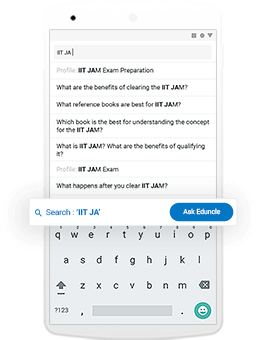Time management is very much important in IIT JAM. The eduncle test series for IIT JAM Mathematical Statistics helped me a lot in this portion. I am very thankful to the test series I bought from eduncle.
Nilanjan Bhowmick AIR 3, CSIR NET (Earth Science)- UGC NET
- English
Do provide general information about jacobson's aspects of language and two types of aphasic disturbances
do provide general information about Jacobson's Aspects of language and two types of aphasic disturbances
- 0 Likes
- 3 Comments
- 0 Shares
-
![comment-profile-img]() >
>
-
![comment-profile-img]() >
>
Deb dulal halder Halder
![best-answer]()
There are two basic types of aphasia and each corresponds to the two principle modes of arrangement: combination and selection. For the selection aphasia “the context is the indispensable and the decisive factor. When presented with scraps of words or sentences, such a patient readily completes them” (121). However, it is difficult for him/her discourse of which he/she is not experiencing first hand (a closed dialogue for example). The more a word is dependent and the more it refers to the context of a sentence the less it will be affected by selection aphasia. “Therefore words syntactically subordinated by grammatical agreement or government are more tenacious, whereas the main subordinating agent of the sentence, viz. the subject, tends to be omitted” (121). Sentences are seen as elliptical devices that are supplied from prior sentences—thus words that serve as connectors or auxiliaries of prior sentences will survive. This means that “. . . only the framework, the connecting links of communication, is spared by this type of aphasia at its critical stage” (122). Jakobson gives the example that a patient never uses the word knife alone but always according to its use and surroundings—“so the knife was changed from a free form, capable of occurring alone, into a bound form” (122). As such, the reverse happens when two equivalent words become two different meanings that cannot be linked to the unifying nature of the words. Jakobson sums this up: “If one of the synonymic signs is present (. . .), then the other sign (. . .) becomes redundant and consequently superfluous. . .Likewise, the picture of an object will cause suppression of its name: a verbal sign is supplanted by a pictorial sign” (123). There is a failure to shift from an icon to its corresponding verbal symbol.
-
![comment-profile-img]() >
>
Deb dulal halder Halder Best Answer
There are two modes of arrangement involved in the formation of a linguistic sign: 1) Combination (contexture): “any sign is made up of constituent signs and/or occurs only in combination with other signs” (119). Selection (substitution): “A selection between alternatives implies the possibility of substituting one for the other, equivalent in one respect and different in another” (119). Combination is based on two or more terms present in the actual series of signs and selection is where signs are selected that mean the same thing but are not present in the phrase. Combination refers to constituents are combined from the storehouse of possible parts of the code whereas selection or substitution signs are linked by similarity. These two operations of arrangements allow two distinct possible interpretants of the sign: one based on the code and the other the context. Linguistic signs are related to one another via two modes: alternation and alignment, each of which is determined via “an internal relation and with the message by an external relation” (120). Separation by space and time, of interlocutors, is crossed by the internal relation based upon equivalent symbols “used by the addresser and those known and interpreted by the addressee” (120).
Do You Want Better RANK in Your Exam?
Start Your Preparations with Eduncle’s FREE Study Material
- Updated Syllabus, Paper Pattern & Full Exam Details
- Sample Theory of Most Important Topic
- Model Test Paper with Detailed Solutions
- Last 5 Years Question Papers & Answers
Sign Up to Download FREE Study Material Worth Rs. 500/-










 >
>








Deb dulal halder Halder
Jakobson says that symbolic logic gives the science of language a distinction between “object language” and “metalanguage,” which further stratifies the nature of language. Metalinguistic operations is the interpretation of “one linguistic sign through other, . . ., signs of the same language in a metalinguistic operation. . .” (123). Metalanguage is essential for the acquisition of language and its normal functions—“The aphasic defect in the ‘capacity of naming’ is properly a loss of metalanguage” (124). An example of this loss is represented in the inability to put together the two words bachelor and unmarried man as being homonyms of one another.